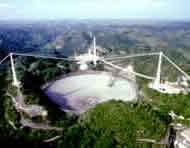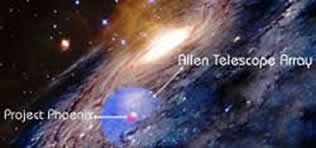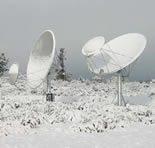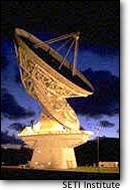|
>> Catalog of Tomorrow Rough Drafts: Deep Sea | SETI | Deep Space
|
|||
|
Tired of the alien-of-the-week as depicted by Star Trek? Jar-Jar Binks bugging you? Are you wondering where the real space sentients are, and if they are wierder than we can even imagine? You are not alone and in all probability, we are not alone either. At least, that's what the folks at SETI the Search for Extra-Terrestrial Intelligence are betting. If you were Jimmy the Greek, would you take the bet? If you knew as much about the universe as bookies know about horse racing, you could figure the odds. First, how many stars does our galaxy have? Of those, how many have planets? Of the stars with planets, how many include planets with thermal activity and water (characteristics enabling the evolution of organic life)? Where life emerged, how often did signal-generating intelligence evolve? Frank Drake, an eminent astronomer, neatly bundled the applicable assumptions into an equation which calculates how many stars might have detectable intelligent life. Unfortunately, the answer depends entirely upon your assumptions and the values you enter into Drake's equation: the answer could be a million or none. (Calculate the odds.) So we are propelled from Drake's Equation to Fermi's Paradox: surely our situation is not unique; assuming other intelligent lifeforms evolved, why haven't we heard from them? Maybe they evolved and self-destructed once they reached the nuclear age. Or perhaps they moved quickly through their radio and TV eras, and are now using laser-based communication systems, or quantum broadcasting, or technologies as yet unimagined by us. Given that a billion-year age gap could potentially exist between their evolution and ours, their use of "magic" communication technologies is not at all unlikely ("any sufficiently advanced technology is indistinguishable from magic;" Arthur C. Clarke). |
|||


 |
|||
|
Thus we need to be clever in scanning stars. Our strategies include focusing on wavelengths which the universe leaves "quiet," making it easier to hear artificial signals; wide-field surveys which scan big sections of sky; targeted searches which focus only on 1,000 nearby "sun-like" stars; and "piggyback" searches of data collected from ordinary radio astronomy which borrow processing power from thousands of volunteers' desktop pcs via the SETI@home screensaver. In the next decade, our search will expand in two dimensions. First, the new Allen Telescope Array in northern California will provide 24/7/365 SETI radio scans via 350 linked 6-meter dishes. Second, projects like COSETI (Columbus Optical SETI) will re-invigorate the search for optical messages beamed at Earth via high-energy, pulse lasers. On August 15th, 1977, Dr. Jerry Ehrman looked through a stack of printouts from Ohio State University's Big Ear Radio Observatory and printed "WOW!" next to a strong signal spike. (see graphic) Unfortunately, that signal never recurred. If it had, what would have happened? Think the movie "Contact" rather than "The X-Files:" any potential "hits" are double-checked against a data-base of potential Earth-based signal sources, and then referred to other radio telescope observatories for independent confirmation. If confirmation occurs, international protocols for next steps and possible responses are being jointly devised by astronomers, diplomats, and space lawyers. |
|||
|
Once we receive an interstellar message, we must interpret it, and respond. In both deciphering alien messages, and designing our own for transmission, we need a clearly understandable reference point. For example, the Rosetta Stone gave us Greek and Egyptian script alongside Egyptian hieroglyphs; Mayan glyphs were understood first in reference to numerals and their calendar. In sending greetings via Voyager and the 1974 transmission from Arecibo, we included numerals, chemical formulae, and stick figures depicting the human body. But starting with math and the elements of the universe does not ensure cross-cultural understanding. Doug Vakoch, the SETI Institute's "Interstellar Message Group Leader," has been working with scientists, artists, and schoolchildren to create messages conveying human intention as well. In an article for the BBC, Maggie Shiels notes, "Dr Vakoch has already devised some basic messages that ET would easily understand. They include things like the periodic table written in a universal language using binary numbers and also a picture of two human beings, one holding the other to represent 'support and caring'." And every year participants at CONTACT explore different protocols for human communication with alien cultures. But let's be honest with ourselves. While we find us endlessly fascinating, that could just be Terran narcissism. What's to say a billion-year-old, highly evolved, intelligent species would find us any more interesting than we find the average earthworm? Or, culturally, any more understandable or admirable? Our home definitions of progress might not be shared by the galaxy. Yet whatever the communication difficulties and cultural barriers involved, the effort alone transforms us. |
|||
|
Organic life, we
are told, has developed gradually from the protozoon to the philosopher,
and this development, we are assured, is indubitably an advance.
Unfortunately it is the philosopher, not the protozoon, who gives
us this assurance. |
|||
|
|||
> Essays > Change > Octopus | Tomorrow | Arts | Governance | America's Futures | Borders
>> Catalog of Tomorrow Rough Drafts: Deep Sea | SETI | Deep Space
| 15
February 2003. Email
IF. Copyright © 2003, Wendy L. Schultz All rights reserved. |
people have explored our infinite futures. (in addition to the 17,500+ visitors from 10/1/2001-12/15/2002). |


















